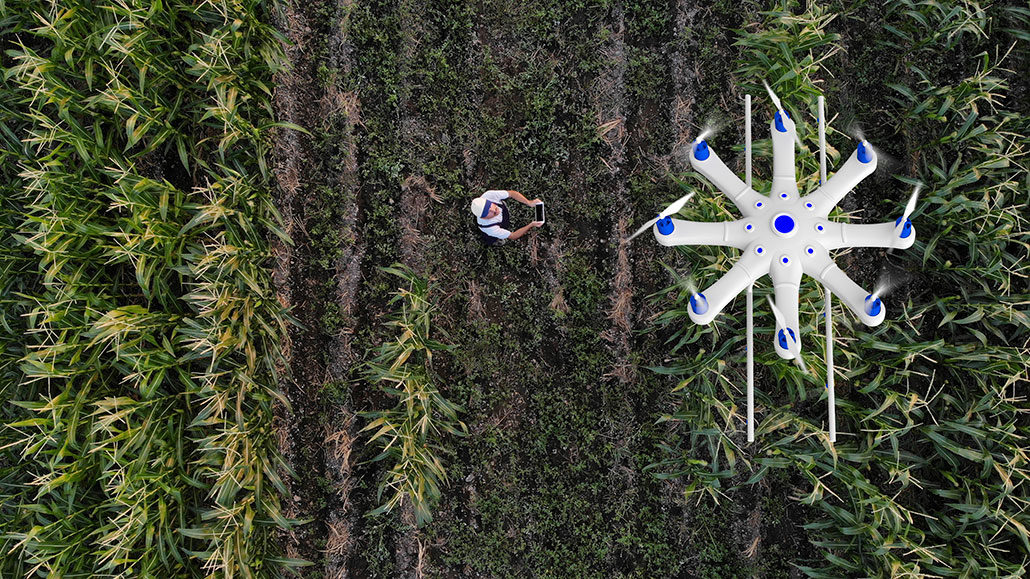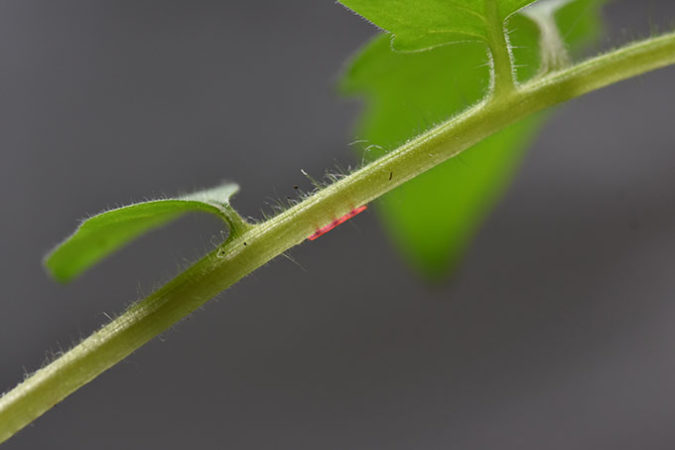Silk-based microneedles may help treat diseased plants
In one test, a drone shot darts to ‘treat’ a tomato plant from the air

On some farms, drones already spray crops with medicine to eliminate pests or weeds. In the distant future, drones may also target plants with shots of medicine — similar to the shots you get at the doctor’s office.
baranozdemir/E+/Getty Images
A drone hovers in front of a tomato plant. Across the room, Yunteng Cao controls the machine from a smart phone. He taps to fire. A small needle explodes out from a toy dart gun that’s attached to the drone. The needle flies straight, piercing the plant’s stem.
Cao smiles. He’s just spent a week trying to dart that tomato stem. “Most times I just missed it,” he says.
Cao is an engineer working on biomaterials at the Massachusetts Institute of Technology, or MIT, in Cambridge. So why was he trying to dart a tomato plant? It was a test of a new type of needle that his team has invented. It has been designed to inject medicine into plants. The drone experiment was one of many tests of the new needle.
Plants get sick, just as people do. Similar to the way COVID-19 sickens and kills people, disease epidemics are wiping out entire groves of bananas, oranges and other crops. To treat plant diseases, farmers usually spray chemicals. Some of these target the germs that cause disease. Other chemicals target the pests that carry those germs. But “less than 5 percent [of the chemicals] go inside the plant,” Cao points out.
The rest ends up in the surrounding soil and water. That’s not good for the environment or for human health, says Benedetto Marelli. He’s an engineer at MIT who oversees Cao’s research. And spraying can’t cure some diseases, right now, because the medicine never reaches the right parts of the plant.
Farmers need a more precise way to give plants medicine. Marelli and Cao hope the system they invented will do the trick. They named it a phytoinjector. (The term phyto, pronounced FY-toh, denotes that the needles are intended for plants.)
Sharp as silk
You probably know what it’s like to get a shot in your arm at the doctor’s office. The phytoinjector delivers medicine very differently. It’s a tiny patch containing even tinier barbs that pierce the plant. Those barbs are microneedles. And they’re made to dissolve. As they do, they release their medicine. Later, the patch falls off or can be removed.
Medical engineers have already developed microneedle patches for people. They are painless and easy to use. A person sticks it onto their skin, just like putting on a Band-Aid.
If these work for people, Marelli and Cao decided, why not for plants?
They have made their microneedles out of silk. Most of the silk in our lives is soft cloth. But the material can be made into hard forms as well for use as medical implants. The silk needles “look like plastic,” Marelli says. But the material is friendlier to living bodies than most plastics.
The MIT team ran into trouble early on because the silk microneedles that work on people did not work on plants. They just didn’t dissolve. The team had to change the recipe for the material. To dissolve as needed, it had to attract more water molecules.

Different sizes of the new phytoinjectors were tested on various types of plants. The researchers created a patch with larger needles to pierce the trunk of an orange tree. A patch with smaller barbs punctured the slim stem of a tomato plant.
Then they conducted tests to see how well the medicine made it into each plant and traveled to either the roots or the leaves. These tests showed the micro-barbs could successfully deliver medicines made from different sized molecules.
Cao’s team described its new drug-delivery system for plants April 22 in Advanced Science.
High-tech farming
In these early tests, the researchers pressed the patches onto plants with tweezers or with their hands. In a huge field or grove, however, it would be too time-consuming and costly to apply the patches by hand. The drone experiment showed that it should be possible to dart trees or plants, one day, remotely from the air.
But not yet. Hitting his target was extremely difficult, Cao observes. And this was in an indoor lab. On a real farm, drones face wind, rain and other difficult conditions. Finding and hitting a slim stem or trunk with a tiny patch clearly poses a challenge.
Phytoinjectors do show promise for other purposes, though. For valuable trees, farmers may be willing to apply patches by hand. The patches might even be used to deliver technology that could modify a plant’s genes. Such changes might make the plants more productive or make them better able to resist disease.
Qingshan Wei is a bioengineer who did not take part in the new research. He works at North Carolina State University in Raleigh. But he’s familiar with the idea. His team, too, is working on microneedle patches for plants. Wei was impressed that the MIT team managed to deliver different types of drugs and have those end up in different parts of a plant, not just where the barbs implanted.
And the new silk material “has a lot of interesting properties,” he notes. But the channels inside a plant that carry nutrients are very tiny. If a needle misses its mark, he worries, the injection won’t work. Also, the MIT team tested only citrus, tomato and tobacco plants. Wei wonders if the same strategy will work on other types as well. Marelli hopes to continue to improve the patches. Biomedical engineering is not just for people, he says. “Plants also need a lot of technology.”







